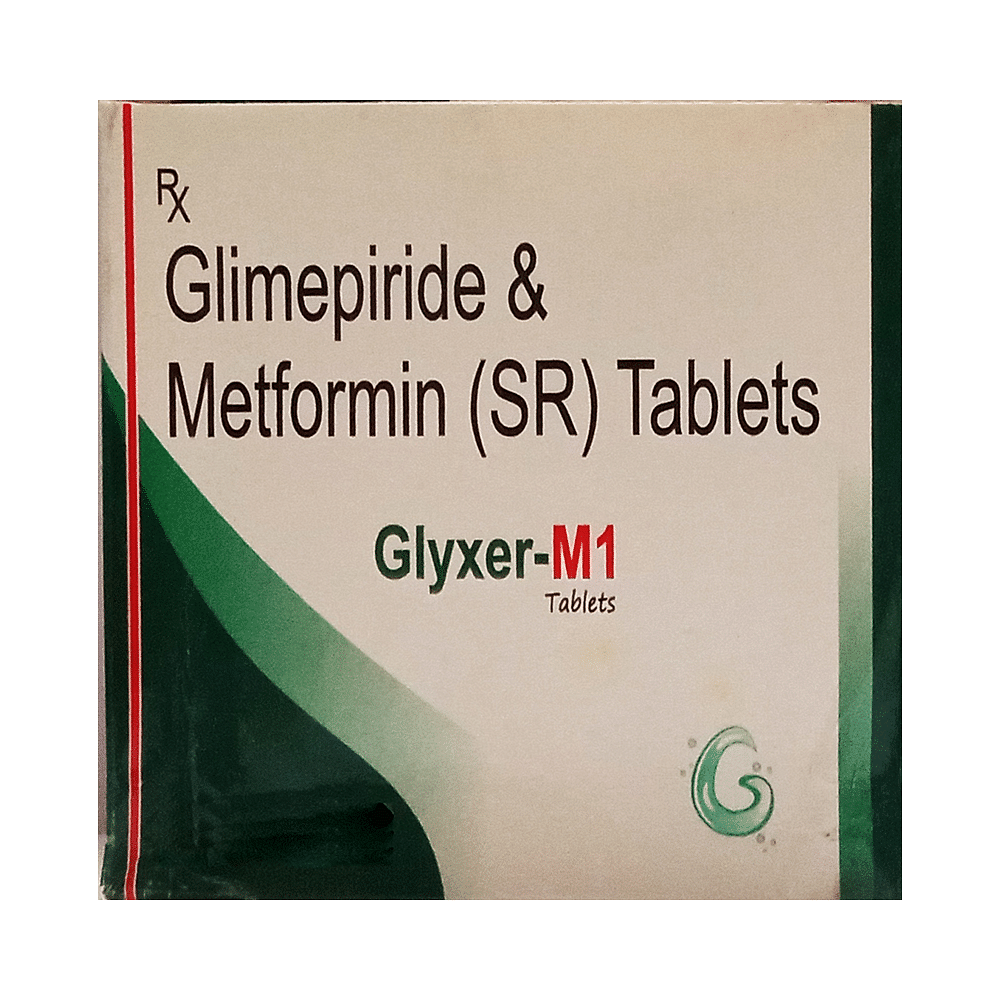
Metagil-GM 1 Tablet SR
Manufacturer
Precise Lifescience
Salt Composition
Glimepiride (1mg) + Metformin (500mg)
Key Information
Short Description
Metagil-GM 1 Tablet SR is a combination of two medicines used to treat type 2 diabetes mellitus in adults. It helps control blood sugar levels in people with diabetes.
Dosage Form
Tablet SR
Introduction
Metagil-GM 1 Tablet SR belongs to a category of medicines known as anti-diabetic drugs. It is a combination of two medicines used to treat type 2 diabetes mellitus in adults. It helps control blood sugar levels in people with diabetes.
Directions for Use
Take this medicine in the dose and duration as advised by your doctor. Swallow it as a whole. Do not chew, crush or break it. Metagil-GM 1 Tablet SR is to be taken with food.
How it works
Metagil-GM 1 Tablet SR is a combination of two antidiabetic medicines: Glimepiride and Metformin. Glimepiride is a sulfonylurea which works by increasing the amount of insulin released by the pancreas in order to lower the blood glucose. Metformin is a biguanide which works by lowering glucose production in the liver, delaying glucose absorption from intestines and increasing the body's sensitivity to insulin.
Quick Tips
Take it with food to lower your chance of having an upset stomach. Monitor your blood sugar level regularly while you are taking this medicine. It can cause hypoglycemia (low blood sugar level) when used with other antidiabetic medicines, alcohol or if you delay or miss a meal. Inform your doctor about your diabetes treatment if you are due to have surgery under a general anesthetic. Tell your doctor immediately if you experience any deep or rapid breathing or if you have persistent nausea, vomiting and stomach pain as Metagil-GM 1 Tablet SR may cause a rare but serious condition called lactic acidosis which is an excess of lactic acid in the blood.
Related Medicines

Isryl-M 1 Tablet

Aconride M 1mg/500mg Tablet SR

Glyxer M 1 Tablet SR

Pride M 1mg/500mg Tablet SR

Apiride MF 1mg/500mg Tablet SR

Limpen M 1mg/500mg Tablet SR

Noxpride GM 1mg/500mg Tablet SR

Glimicer M 1mg/500mg Tablet SR

Glivion M 1mg/500mg Tablet SR

Kromet-G 1 Tablet SR
Frequently asked questions
What are the recommended storage conditions for Metagil-GM 1 Tablet SR?
Keep this medicine in the container or the pack it came in, tightly closed. Store it according to the instructions mentioned on the pack or label. Dispose of unused medication.
Can the use of Metagil-GM 1 Tablet SR lead to lactic acidosis?
Yes, using Metagil-GM 1 Tablet SR can potentially lead to lactic acidosis. It's a serious medical condition that occurs when there is an increase in blood lactic acid levels. This condition is often referred to as MALA (Metformin-associated lactic acidosis). While this side effect is rare, it is particularly relevant for individuals with pre-existing kidney issues, older adults, or those who consume significant amounts of alcohol.
What is Metagil-GM 1 Tablet SR?
Metagil-GM 1 Tablet SR combines two medications: Glimepiride and Metformin. These medications are used in the management of type 2 diabetes mellitus (DM). Glimepiride reduces blood sugar levels by stimulating insulin release from the pancreas, while Metformin works by decreasing glucose production in the liver and enhancing insulin sensitivity. This combination is specifically for type 2 diabetes.
What are the possible side effects of Metagil-GM 1 Tablet SR?
Common side effects include hypoglycemia (low blood sugar), altered taste, nausea, stomach pain, diarrhea, and headache. It's crucial to be aware that serious but rare side effects can also occur, such as lactic acidosis. In the long term, Metagil-GM 1 Tablet SR might lead to Vitamin B12 deficiency.
Can Metagil-GM 1 Tablet SR cause Vitamin B12 deficiency?
Yes, prolonged use of Metagil-GM 1 Tablet SR may result in Vitamin B12 deficiency. It interferes with the absorption of Vitamin B12 in the stomach. If untreated, this can lead to anemia and nerve problems, manifesting as tingling sensations in hands and feet, weakness, urinary issues, altered mental status, and difficulties maintaining balance (ataxia). To mitigate potential risks, it's recommended to consume a source of vitamin B12 through dietary supplements at least once annually.
Can Metagil-GM 1 Tablet SR cause hypoglycemia?
Yes, Metagil-GM 1 Tablet SR can lead to hypoglycemia (low blood sugar level). Symptoms include nausea, headache, irritability, hunger, sweating, dizziness, fast heart rate, and feelings of anxiety or shakiness. This is more likely if you miss meals, drink alcohol excessively, overexert yourself, or take other medications for diabetes in conjunction with it. Regular monitoring of your blood sugar levels during treatment is important.
Is it safe to take alcohol while taking Metagil-GM 1 Tablet SR?
No, mixing alcohol with Metagil-GM 1 Tablet SR is not advisable as it can lower blood sugar levels and increase the risk of hypoglycemia. Additionally, this combination may also increase the chance of developing lactic acidosis.


